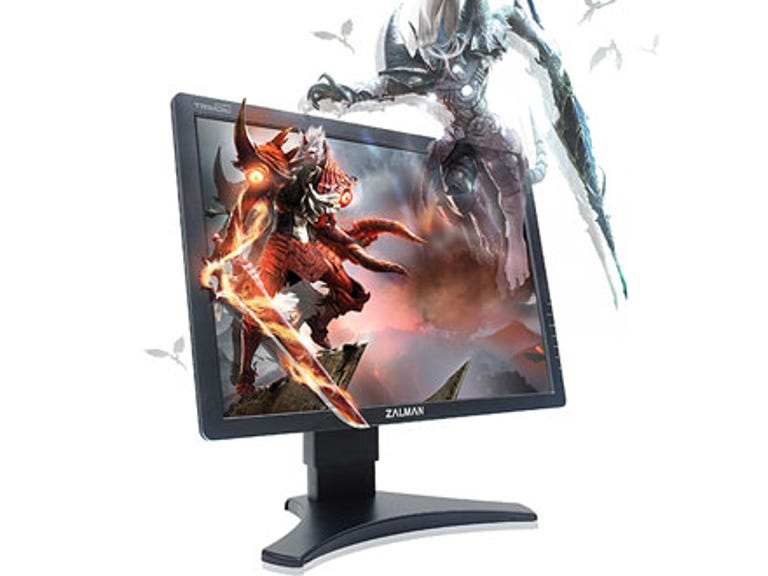 Why You Can Trust CNET
Why You Can Trust CNET Zalman ZM-M220W review: Zalman ZM-M220W
The Zalman ZM-M220W is a very good gaming monitor, with decent contrast and colours, but the 3D capabilities aren't as special as we'd hoped.
One of the highlights of this year's CES was the introduction of a sensible 3D video solution -- namely these Zalman monitors. While Samsung was also displaying a 3D TV at its booth, it's in monitors that we can see immediate benefits for gamers. Not the least because the Samsung needs to be hooked up to a PC to work anyway.
The Good
The Bad
The Bottom Line
Design
For Zalman's first monitor, it's not a bad looking beastie at all: it's black -- though thankfully not piano-so -- and has an attractive, bio-hazard type stand. The monitor is height adjustable, and also swivels for easier adjustment.
The 22-inch screen features a coating which serves two purposes: a) to provide higher contrast and b) it enables the 3D glasses to work.
Features
Of course, the reason you'd buy this monitor over a cheaper model is for the 3D mode. The effect works by using polarising filters -- such as used in sunglasses -- for each alternating line of pixels. Each line corresponds to one or other of the lenses, and this in turn creates a stereo image. While it sounds tricky, what it means is that there's no need for clunky headsets or blue and red cellophane -- just a pair of slimline glasses.
Zalman have thoughtfully included two sets of glasses in the package: one a fairly nerdy looking pair of sunglasses and the other an even nerdier pair of clip-ons.
However, there are several caveats to getting the stereo glasses working. First, your computer must have an NVIDIA graphics card -- the American manufacturer makes the only driver that supports 3D vision. Second, the application needs to support it.
Unlike the similarly-priced (and superior) Dell 2408WFP the inputs are quite minimal, with only a D-Sub and a DVI connection. The other specifications are fairly similar to models we've seen before: 1000:1 contrast ratio, 5ms response rate and a small set of 2W speakers behind the bezel -- blink and you'll miss them.
Performance
As a normal 2D monitor, the ZM-M220W behaves very well. Gaming is a blast, and though the black levels aren't as deep as some monitors we've seen it doesn't seem to hinder performance at all. DVD watching was also good, and the 1680 x 1050 resolution gives more than enough real estate for most media.
Colour reproduction was good even though uniformity wasn't the best with greys and blacks in particular appearing patchy and not consistent from end to end. Also, and on a minor note, alternating strips of the polarising filter are visible at a normal viewing distance. They appear as a series of horizontal lines -- similar to what you'd see on a CRT monitor, only a little fainter. This didn't affect normal usage.
But it's the monitor's 3D capabilities you want to know about right? So how are they, you ask. Well, we'll heap it with faint praise when we say it's the best 3D system we've seen yet. Which is to say: it's still not there.
Like most systems, your eyes tire after about five minutes and any extra immersion is counterbalanced by the potential for migraine. The effect, once you've set it up, is similar to trying to concentrate on one of those Magic Eye pictures for a long time -- except that it's continually moving
Some games are more successful than others, and usually the 3D Stereo Control Panel will tell you upfront which ones these are. We tried a wide smattering of games including Call of Duty 4, Warhammer 40,000 Dawn of War, and Half Life 2. The most successful of which was CoD4 but it still became quite tiring.
However, getting to this point proved quite frustrating. We tried several different "supported" systems with no success, and only when we stumbled upon an NVIDIA driver posted on Zalman's support pages did our 7800GTX work in Windows Vista. While we did manage to get the video viewer to work on our GeForce Go laptop, the hardware visibly struggled to get the demo file to run at a decent speed.
For best results you'll need to set the game's resolution to your desktop resolution (in this case the screen's native 1680 x 1050) or you won't get a stereo effect. This is problematic if the game doesn't support this resolution, and you'll also need to experiment with the distance you sit from the screen to get a stereo effect. Of course, we think these problems have as much to do with the drivers as they do the monitor itself -- we're hoping a "viewing distance" option in future drivers will fix this.
Conclusion
The Zalman ZM-M220W is a very good gaming monitor and we think a lot of people will be attracted to the 3D capabilities and, while they do work, we don't see anyone using them for any extended period of time.


